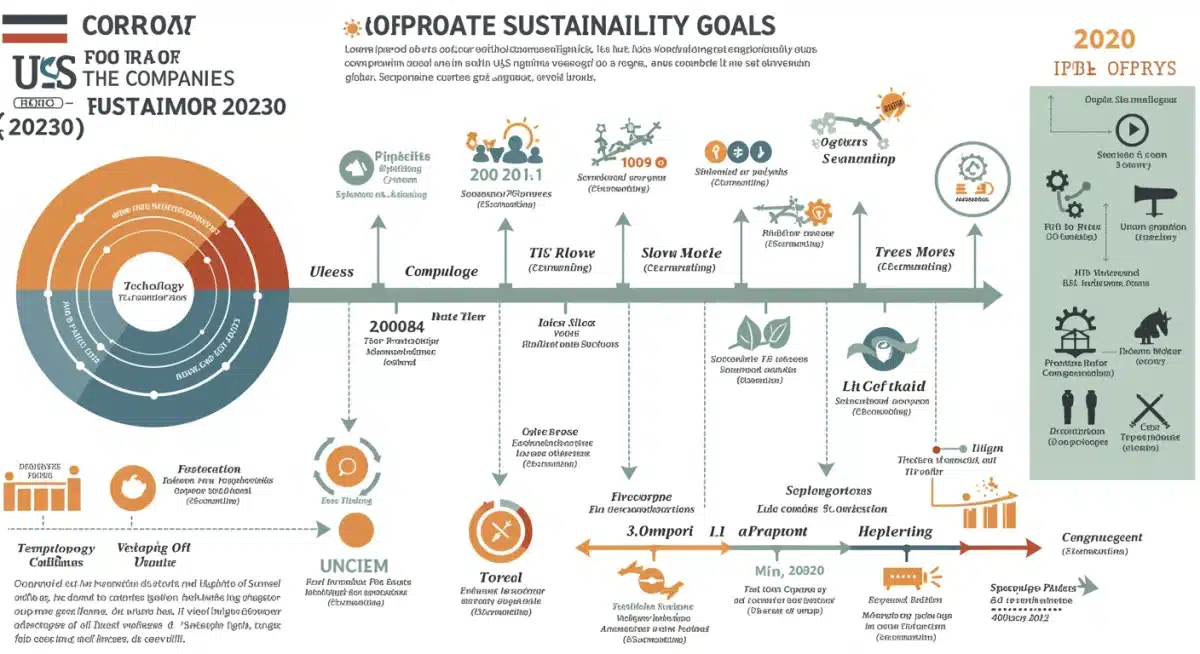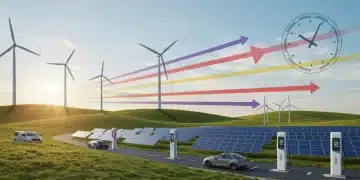US Companies: Carbon Neutrality by 2030 – A Deep Dive

Fifty major US companies are actively pursuing carbon neutrality by 2030, implementing diverse strategies from renewable energy adoption to supply chain optimization, marking a significant shift in corporate environmental responsibility across the nation.
Corporate carbon neutrality 2030 is not just an aspiration but a tangible goal for a growing number of major US corporations. This ambitious commitment reflects a critical pivot towards sustainable practices, driven by increasing environmental awareness, regulatory pressures, and consumer demand for responsible business operations.
The Imperative for Corporate Carbon Neutrality by 2030
The call for immediate climate action has intensified globally, pushing corporations to re-evaluate their environmental footprints. Achieving carbon neutrality by 2030 means balancing carbon emissions with carbon removal, effectively reducing a company’s net impact on the atmosphere to zero. This objective is becoming a cornerstone of modern corporate responsibility, influencing investment decisions, brand reputation, and long-term viability.
Many leading US companies recognize that proactive engagement in climate solutions is no longer optional but essential for future success. This involves comprehensive strategies that address emissions across all scopes: direct emissions from owned or controlled sources (Scope 1), indirect emissions from purchased electricity, steam, heating, and cooling (Scope 2), and all other indirect emissions that occur in a company’s value chain (Scope 3). The complexity of Scope 3 emissions often presents the greatest challenge, requiring collaboration with suppliers and partners.
Driving Forces Behind the 2030 Target
- Regulatory Landscape: While federal regulations in the US have varied, state-level initiatives and international agreements like the Paris Accord continue to exert pressure.
- Investor Demands: Environmental, Social, and Governance (ESG) factors are increasingly influencing investment decisions, with investors scrutinizing companies’ climate commitments.
- Consumer Expectations: A growing segment of consumers prioritizes brands with strong sustainability credentials, impacting purchasing behavior and brand loyalty.
- Reputational Benefits: Leading on climate action enhances corporate image, attracts top talent, and fosters innovation within the organization.
The urgency stems from scientific consensus on climate change, which underscores the need for rapid decarbonization. Companies setting 2030 targets are positioning themselves as leaders in a critical decade for climate action, demonstrating a deep commitment to mitigating the impacts of a warming planet.
Strategies for Achieving Carbon Neutrality
Fifty major US companies are employing a diverse array of strategies to reach their carbon neutrality goals by 2030. These approaches often involve a combination of internal emission reductions, renewable energy procurement, and carbon offsetting initiatives. The specific mix of strategies varies greatly depending on the industry, operational scale, and existing infrastructure of each company.
Many companies are significantly investing in renewable energy sources. This includes purchasing renewable energy credits (RECs), entering into power purchase agreements (PPAs) for solar or wind farms, and even developing their own on-site renewable energy generation facilities. This direct investment not only reduces Scope 2 emissions but also contributes to the broader expansion of clean energy infrastructure.
Key Strategic Pillars
- Renewable Energy Transition: Shifting operations to 100% renewable electricity through PPAs, RECs, and on-site generation.
- Energy Efficiency Improvements: Implementing advanced building management systems, upgrading equipment, and optimizing operational processes to reduce energy consumption.
- Supply Chain Decarbonization: Collaborating with suppliers to reduce emissions across the value chain, often through incentives, shared best practices, and innovative technologies.
- Sustainable Transportation: Electrifying vehicle fleets, optimizing logistics, and promoting eco-friendly commuting options for employees.
- Carbon Capture and Offsetting: Investing in projects that remove carbon from the atmosphere, such as reforestation, direct air capture, or verified carbon credits, as a last resort for unavoidable emissions.
Beyond these direct actions, companies are also focusing on innovation and technology development. This includes researching and deploying new low-carbon materials, optimizing product lifecycles, and fostering a culture of sustainability among employees. The holistic nature of these strategies highlights the complexity and dedication required to achieve genuine corporate carbon neutrality 2030.
Sector-Specific Approaches and Innovations
The path to carbon neutrality looks different across various industries. Technology giants, for instance, often focus on optimizing data center energy efficiency and procuring vast amounts of renewable energy. Companies like Microsoft and Google have been at the forefront, not only achieving but often exceeding their initial carbon reduction targets through significant investments in renewable energy and innovative cooling technologies for their server farms. Their strategies frequently include long-term power purchase agreements that guarantee a supply of clean energy for decades.
In contrast, manufacturing and industrial sectors face unique challenges due to energy-intensive processes and reliance on fossil fuels. Companies in these areas are exploring carbon capture technologies, electrifying industrial processes, and redesigning production methods to minimize waste and emissions. For example, some automotive manufacturers are investing heavily in electric vehicle production and working to decarbonize their entire supply chain, from raw material extraction to end-of-life recycling. This requires significant capital investment and a willingness to embrace disruptive technologies.
Diverse Industry Examples
Retail companies are often tackling emissions related to their vast logistics networks and extensive physical store footprints. This includes optimizing delivery routes, converting fleets to electric vehicles, and implementing energy-efficient designs in their stores. Walmart, for instance, has committed to achieving an emissions-free logistics fleet by 2040, alongside other ambitious sustainability goals, impacting thousands of suppliers.
The financial services sector, while having a smaller direct operational footprint, plays a crucial role through its investment and lending practices. Banks and investment firms are increasingly integrating climate risk into their financial models and directing capital towards green projects and companies committed to decarbonization. This indirect influence can accelerate the transition to a low-carbon economy significantly.
Each sector’s approach underscores the need for tailored solutions and innovative thinking to address specific emission sources effectively. The commitment to corporate carbon neutrality 2030 is driving unprecedented innovation across the US economy.
Challenges and Hurdles on the Path to 2030
Despite the strong commitments, achieving carbon neutrality by 2030 is fraught with significant challenges. One of the primary hurdles is the sheer complexity of Scope 3 emissions, which often account for the largest portion of a company’s carbon footprint. These emissions occur outside a company’s direct control, residing within its supply chain, product use, and end-of-life phases. Influencing suppliers to adopt sustainable practices, especially smaller entities, requires significant effort, resources, and often, financial support.
Another major challenge lies in the scalability and availability of renewable energy and carbon removal technologies. While solar and wind power are becoming more prevalent, ensuring a consistent, 24/7 supply of clean energy for large-scale operations remains complex. Furthermore, nascent technologies like direct air capture are still expensive and not yet widely deployed, limiting their current utility as a primary solution for many companies.
Obstacles to Overcome
- Supply Chain Engagement: Convincing and enabling thousands of suppliers to measure and reduce their emissions.
- Technological Limitations: The current state and cost of certain decarbonization technologies, especially for hard-to-abate sectors.
- Financial Investment: Significant upfront capital expenditure required for transitioning to new infrastructure and processes.
- Data Collection and Reporting: Establishing robust systems for accurate and transparent measurement of emissions across all scopes.
- Policy Uncertainty: Fluctuating regulatory environments at federal and state levels can complicate long-term planning and investment.
The economic implications of transitioning to a low-carbon economy also present a hurdle. While long-term benefits are clear, the short-term costs associated with new equipment, technologies, and operational changes can be substantial. Companies must balance these investments with shareholder expectations and market competitiveness. Overcoming these challenges will require sustained corporate resolve, technological advancements, and supportive policy frameworks to truly achieve corporate carbon neutrality 2030.

The Role of Collaboration and Innovation
Achieving carbon neutrality by 2030 is rarely a solitary endeavor. Many US companies are finding that collaboration across industries, with governments, and even with competitors, is essential to overcome common challenges and accelerate progress. Partnerships can facilitate the sharing of best practices, co-development of new technologies, and collective lobbying for supportive policies. For instance, industry consortia are emerging to tackle sector-specific decarbonization pathways that no single company could easily address alone.
Innovation is also a critical driver. This extends beyond technological breakthroughs to include innovative business models, financing mechanisms, and policy instruments. Companies are investing in research and development, supporting startups focused on climate solutions, and exploring circular economy principles to minimize resource use and waste. The development of new materials, more efficient processes, and advanced data analytics for emission tracking are all part of this innovative push.
Forms of Collaboration and Innovation
- Industry Alliances: Companies pooling resources to develop shared solutions for decarbonization challenges.
- Public-Private Partnerships: Collaborating with government agencies on infrastructure projects or policy development that supports climate goals.
- Open Innovation Platforms: Sharing intellectual property or data to accelerate the development of climate technologies.
- Venture Capital Investments: Funding promising startups in renewable energy, carbon capture, and sustainable materials.
Such collaborative efforts not only amplify the impact of individual company initiatives but also create a more robust ecosystem for sustainable development. This collective momentum is vital for meeting the aggressive timeline of corporate carbon neutrality 2030, recognizing that systemic change requires systemic solutions.
Broader Impact and Future Outlook
The commitment of 50 major US companies to achieve carbon neutrality by 2030 has far-reaching implications beyond their immediate operations. This trend is setting new benchmarks for corporate responsibility, influencing smaller businesses, supply chains, and even national climate policy. As these corporate giants demonstrate the feasibility and benefits of decarbonization, it creates a ripple effect, encouraging other entities to follow suit and accelerating the overall transition to a low-carbon economy.
Economically, this shift is spurring significant investment in green technologies and infrastructure, creating new jobs and fostering economic growth in sustainable sectors. It’s also redefining competitiveness, with companies that integrate sustainability into their core business models gaining a strategic advantage. The financial markets are increasingly rewarding companies with strong ESG performance, reflecting a growing recognition of climate risk and opportunity.
Long-Term Implications
Environmentally, the collective effort to reduce emissions will contribute significantly to mitigating global warming and its associated impacts, such as extreme weather events and sea-level rise. While these 50 companies alone cannot solve the climate crisis, their leadership provides a powerful example and tangible progress towards a more sustainable future. Their actions help to demonstrate that economic prosperity and environmental stewardship are not mutually exclusive but rather interdependent.
The future outlook suggests that the 2030 target will serve as a critical milestone. As companies achieve these goals, the focus will likely shift towards even more ambitious targets, such as net-zero emissions across all scopes without relying on offsets, and ultimately, carbon negativity. This ongoing evolution of corporate climate goals underscores a fundamental reorientation of business towards long-term planetary health, making corporate carbon neutrality 2030 a pivotal moment in this journey.

Key Focus Area |
Brief Description > |
|---|---|
Renewable Energy |
Transitioning to 100% clean power through PPAs, RECs, and on-site generation. |
Supply Chain Decarbonization |
Engaging suppliers to reduce Scope 3 emissions across the value chain. |
Innovation & Collaboration |
Investing in new technologies and forming partnerships to accelerate climate solutions. |
Economic & Environmental Impact |
Driving green investments, creating jobs, and contributing significantly to climate mitigation. |
Frequently Asked Questions About Carbon Neutrality
Carbon neutrality means a company has achieved a net-zero release of carbon dioxide into the atmosphere. This is done by balancing the amount of carbon dioxide released with an equivalent amount sequestered or offset, often through renewable energy and carbon removal projects.
The 2030 target aligns with critical scientific recommendations for limiting global warming to 1.5°C. It demonstrates an urgent commitment to climate action, driven by investor pressure, consumer demand, and the recognition of long-term business resilience in a changing climate.
Scope 1 covers direct emissions from owned sources. Scope 2 includes indirect emissions from purchased energy. Scope 3 encompasses all other indirect emissions in a company’s value chain, such as those from suppliers, product use, and employee commuting, often the most challenging to tackle.
Addressing Scope 3 emissions involves collaborating with suppliers to improve their environmental performance, optimizing logistics, promoting sustainable product design, and encouraging eco-friendly consumer behavior. This often requires incentives, data sharing, and joint innovation initiatives across the value chain.
Carbon offsets are used to compensate for unavoidable emissions by investing in projects that reduce or remove greenhouse gases elsewhere. While essential for achieving neutrality, companies prioritize direct emission reductions first. Offsets are generally considered a supplementary measure for residual emissions.
What this means
The concerted effort by 50 major US companies to achieve corporate carbon neutrality 2030 signals a fundamental shift in business priorities, moving climate action from periphery to core strategy. This proactive stance not only demonstrates environmental leadership but also sets a precedent for broader industry adoption. As these companies navigate the complexities of decarbonization, their successes and challenges will provide invaluable lessons for others, shaping the future of sustainable business and accelerating the global transition to a net-zero economy. We will continue to monitor their progress and the evolving landscape of corporate climate commitments.





